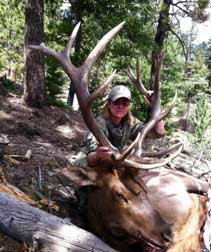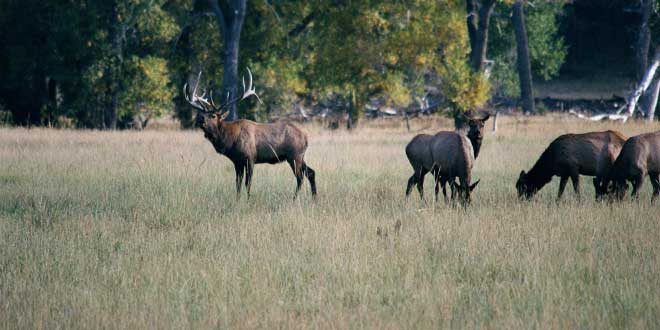Chasing bugling bull elk through New Mexico mountains each fall is not just something a hunter does; it can be an all-consuming passion.
There is something magical about hearing a bull elk bellow his challenge to other elk in the area, whether on a piñon/juniper mesa or in a quaking aspen-covered canyon.
It is a special time of year.
 Those who have never considered an archery elk hunt may want to give it some consideration. Not only will the hunt be challenging and fun, but it’s also a means to fill a freezer with lean, healthy game meat.
Those who have never considered an archery elk hunt may want to give it some consideration. Not only will the hunt be challenging and fun, but it’s also a means to fill a freezer with lean, healthy game meat.
To help those new to archery hunting get off to a good start, below are some tips, tactics and advice about the art of hunting elk with a bow and arrow.
Do the homework
It can take years to draw for an elk hunt, so be sure to put in the time and leg work necessary for a successful hunt beforehand. It would serve an individual well to purchase maps and use a GPS unit (with the land status program) to learn the lay of the land and ownership.
Those able to legally hunt private land should obtain written permission in advance of the hunt.
Speaking to biologists and conservation officers with the New Mexico Department of Game and Fish, along with individuals from land management agencies for a particular area, can be beneficial in understanding where you can find elk.
Then get out and find the elk.
Look for tracks, droppings, old rubs and the elk themselves. Find the water sources they may be using and spend time learning the unit. Also, take the time to read the Hunting Rules and Information Booklet and call the appropriate land management agency regarding any fire, road or camping restrictions.
Finally, it is always wise to formulate a hunting plan to be shared with family and friends. Providing a location and hunting area is an important safety measure.
Elk-Hunting Shape
Take time to hike, jog and utilize weights at the gym. Getting in shape will ensure that you are physically fit for whatever the mountain throws at you. I recommend at least three months of conditioning; this is what works best for me.
Practice Makes Perfect
Shoot as often as possible with the same equipment used on the hunt; practice judging distances and stay within a comfort, or accuracy, zone. In addition, it is important to shoot from different positions, such as standing and kneeling. Broadheads can fly differently than field tips, so make sure to sight in with the same tips that will be used during a hunt and ensure they are sharp.
Practicing in the same clothes you plan on hunting in is also important for both consistency and accuracy. An arm guard is recommended to keep clothing out of the path of an arrow string.
It isn’t only about the shot. The time to start practicing elk calls is well in advance of the actual hunt. A hunter must become proficient in using their elk calls of choice, such as bugles, grunts and cow/calf calls. A little research will reveal a host of elk calls on the market.
Calling alone does not guarantee success, but calling in conjunction with getting ahead of the elk will improve the odds of harvesting. It is essential to maintain a favorable wind direction and to try and head the elk off where they are headed. A hunting partner who can call in the elk past a hunter’s location can be beneficial.
Clothing and Packs
Although bulls may have singular thoughts during the rut, they have not lost the sense of smell. Wash camouflage clothing in hunting-type detergents and keep clean clothing out of the odors of camp, such as cooked food smells and campfire smoke. Store clothing in plastic bags that have baking soda along with vegetation from the area to be hunted. Also, be sure to purchase quiet camouflage and rain gear that blends into the environment.
Preparation also means packing what will be needed in your pack. Suggestions include a sharp knife, headlamp or flashlight (with spare batteries), a pen, rope or cordage, game bags, compass, map, fire-starting material, waterproof matches in a waterproof container, a metal match, drinking water, a water purification system, snacks, toilet paper, signal mirror, space blanket, GPS (with spare batteries), first-aid kit, rain gear, marking ribbon, written permission for hunting on private land (if applicable) and proper hunting license and stamps. I also recommend a rangefinder and a set of binoculars for your hunt.
Rattling Antlers and Rubbing Trees
During the hunt, and once elk calls have been mastered, consider incorporating the sound of two bulls fighting. Rattling is done by carrying around a large set of mule deer shed antlers. Banging and rubbing the antlers together imitates the sound of two bulls fighting.
A large stick or one of the antlers can also be used to rub trees to imitate a bull elk rubbing his antlers on the trees. Rubbing is a common practice of bulls during the rut and may help bring elk into archery range.
Sitting waterholes is a western tradition
The key here is to primarily only sit waterholes in the evening hours when elk tend to search out water sources to quench their thirst from the midday heat. The key is to sit water on the downwind side of any trails or downwind of where you expect elk to come into water.
Set up a tree stand or ground blind in the brush or trees for concealment, but make sure the shooting lanes are void of any branches.
Tall tales of tree stands and trails
If waterholes are in short supply or other hunters are sitting them, consider moving to greener pastures and set up a tree stand along a well-used game trail that leads from bedding areas to water sources or meadows where elk feed at night.
Wishing for wallows
If you are lucky enough to find an elk wallow, this is a great location to set up a tree stand or ground blind. Bulls tend to visit these locations to bathe themselves in mud, and setting up here can prove to be a successful tactic. The best times to sit wallows can be mid-day until evening hours.
Decoys
Try using an elk decoy in conjunction with your set-up when calling, and this may be enough to lure a rut-crazed bull elk closer for a perfect shot. With whatever method you choose to hunt, make sure to keep the wind in your favor!
Give it time
After taking your shot, give your animal time to expire. After a well-placed shot into the vitals, a hunter should wait at least an hour before taking up the trail. Learn to read blood signs. If a marginal hit happens, give the animal plenty of time. Research can aid in the amount of time one needs to wait before trailing the animal. Tracking is a skill that takes practice and patience.
Take care of your harvested animal
After getting an elk, make sure to get it field dressed quickly and get the hide off as soon as possible. While there is more than one method, after skinning and quartering an elk, cut slits into the meat and down to the bone, so the meat does not bone sour. Elk have large femur bones that can hold the heat longer during the warmer seasons of archery hunts. All edible meat must be taken, including all four quarters, neck meat, backstraps and tenderloins.
Deboning an elk is a great option as well. Deboning is an excellent reason to carry game bags in a hunting pack so that the elk can be properly field dressed and the meat stays clean, dry and cool. A sturdy pack frame is a must!
Also, having an ice chest in camp with ice can cool the meat quickly. Immediately after harvesting the animal, tag it.
Simple Elk Stew
• One electric pressure cooker
• One pound of elk meat (ground or steaks)
• One bag of carrots
• One bag of celery
• Four of five potatoes
• One whole onion
• Garlic salt
• Pepper
• Water
Cut the elk meat into bite-size pieces, trimming any fat or connective tissue from the meat before cooking. Wash all of the vegetables and cut them into bite-size pieces. Peel and chop up the onion into pieces. Place all the meat and vegetables into the electric pressure cooker and fill with water (recommendations on how far to fill up can vary, so follow manufacturer instructions). Season to taste with pepper and garlic salt and cook for approximately 35 minutes (or per manufacturer suggestions). If there is a setting for soup/stew, cook on this setting. After all of the ingredients are cooked and the pressure cooker is depressurized (by manufacturer suggestions), allow the ingredients to cool and serve with biscuits or cornbread and some cheese.
 New Mexico Wildlife magazine Conserving New Mexico's Wildlife for Future Generations
New Mexico Wildlife magazine Conserving New Mexico's Wildlife for Future Generations
